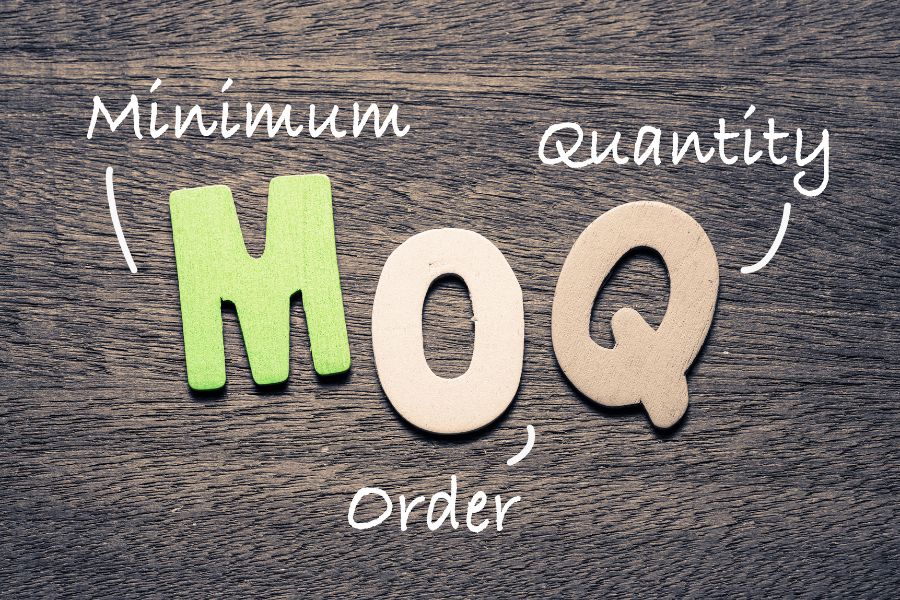MOQ meaning holds significant importance in business transactions, affecting both suppliers and buyers. In this article, we will explore the essence of MOQ and its benefits. By examining its impact on production costs, inventory management, pricing, and supplier-buyer relationships, we aim to provide a concise understanding of this crucial business factor. Whether you are new to MOQ or seeking to deepen your knowledge, join us as we unravel the concept of MOQ and its practical implications in the dynamic world of commerce.
What is MOQ meaning?
MOQ meaning stands for “Minimum Order Quantity.” It refers to the lowest quantity of a product that a supplier is willing to sell or that a buyer must purchase in a single order. The MOQ is typically set by the manufacturer or supplier to ensure that it is economically viable for them to produce or supply the product. It helps them cover their costs and maintain profitability.
The MOQ can vary depending on the product, supplier, and industry. For example, a supplier may have an MOQ of 100 units for a particular item, meaning that a buyer must purchase at least 100 units to place an order.
What effect does the minimum order quantity have on inventory?
The impact of Minimum Order Quantity (MOQ) on inventory can vary depending on whether the MOQ is high or low. Here’s how each scenario can affect inventory:
High MOQ
- Increased inventory: With a high MOQ, a buyer is required to order a larger quantity of products. This can lead to an increase in inventory levels as the buyer needs to stockpile more items to meet the MOQ.
- Inventory holding costs: Holding excess inventory can result in higher carrying costs, including warehousing, storage, insurance, and potential obsolescence costs. These costs can impact the overall profitability of a business.
- The tie-up of capital: A higher MOQ may require a larger upfront investment to purchase the required quantity of products. This tied-up capital could have been used for other purposes or investments.
- Potential stockouts: If the demand for a product is uncertain or the buyer cannot meet the high MOQ, it may result in stockouts. This can impact sales and affect dissatisfied customers.
Low MOQ
- Reduced inventory: A low MOQ allows buyers to order smaller quantities, which can help reduce inventory levels. This is especially beneficial for businesses with limited storage space or for products with unpredictable demand.
- Lower inventory holding costs: With lower inventory levels, the carrying costs associated with holding excess stock are reduced. This can positively impact the profitability of a business.
- Flexibility and responsiveness: A low MOQ enables businesses to respond quickly to changes in customer demand or market trends. It allows for more frequent orders and adjustments to inventory levels as needed.
- Increased variety: With a low MOQ, businesses have the opportunity to carry a wider range of products, offering customers more options and potentially increasing sales.
Benefits of MOQs
MOQs (Minimum Order Quantities) can offer several benefits for both suppliers and buyers. Here are some of the advantages for each party:
Benefits for Suppliers
- Economies of scale: By setting MOQs, suppliers can encourage buyers to order larger quantities, which enables the supplier to take advantage of economies of scale in production. Producing in bulk typically reduces per-unit costs, allowing suppliers to achieve higher profitability.
- Cost recovery: MOQs help suppliers ensure that the costs associated with production, raw materials, and logistics are covered. By setting a minimum quantity, suppliers can avoid small orders that may not be economically viable or profitable for them.
- Efficient production planning: Having predictable order quantities through MOQs allows suppliers to plan their production and optimize their manufacturing processes more efficiently. It helps them streamline their operations, minimize waste, and enhance overall productivity.
- Inventory management: MOQs assist suppliers in managing their inventory levels more effectively. By specifying a minimum order quantity, suppliers can reduce the risk of excess inventory or stockouts, leading to better inventory control and improved cash flow.
Benefits for Buyers
- Price negotiation: MOQs can provide buyers with an opportunity to negotiate better pricing and terms with suppliers. By committing to larger order quantities, buyers may be able to secure volume discounts or more favorable pricing structures, resulting in cost savings.
- Inventory control: For buyers, MOQs can help in managing their inventory levels efficiently. By ordering larger quantities, they can ensure a consistent supply of products and reduce the risk of stockouts. It also allows them to plan their inventory needs better and optimize their replenishment cycles.
- Supplier partnerships: Meeting MOQ requirements can help buyers establish stronger relationships with suppliers. By demonstrating a commitment to larger orders, buyers can build trust and collaboration, which may lead to improved service, priority access to supply, and the potential for customized or exclusive products.
- Cost efficiency: Through MOQs, buyers can achieve cost efficiencies in their operations. By consolidating their orders into larger quantities, they can minimize order processing costs, shipping expenses, and administrative overhead associated with managing multiple smaller orders.
Types of MOQs
When it comes to Minimum Order Quantities (MOQs), they can be categorized into two main types: simple MOQs and complex MOQs. Here’s an overview of MOQ meaning type-wise:
Simple MOQ
- Fixed quantity: Simple MOQs involve a straightforward, fixed quantity that must be met or exceeded to place an order. For example, a supplier may set a simple MOQ of 100 units, meaning that the buyer must order at least 100 units to meet the MOQ requirement.
- Easy to understand: Simple MOQs are clear and easy to comprehend. There is no complexity or additional conditions attached to the minimum order quantity. It simplifies the purchasing process for buyers as they know exactly how many units they need to order to meet the MOQ.
- Commonly used: Simple MOQs are commonly used across various industries, especially for standardized products with stable demand patterns.
Complex MOQ
- Tiered or graduated structure: Complex MOQs involve a tiered or graduated structure, where different order quantities trigger different pricing or other incentives. For example, a supplier might have a complex MOQ that offers a lower price per unit if the buyer orders 500 units but an even lower price if they order 1,000 units.
- Customized requirements: Complex MOQs can include customized requirements based on specific factors such as product variations, customization options, or buyer preferences. For instance, a supplier might have different MOQs for different colors or sizes of a product.
- Negotiable and flexible: Complex MOQs often offer more flexibility for negotiation between buyers and suppliers. The buyer may have the opportunity to negotiate the MOQ based on their specific needs, and the supplier can customize the MOQ based on the buyer’s requirements.
- Used in various scenarios: Complex MOQs are frequently used for products with diverse options, and customizations, or where buyers have different purchasing power or specific demands.
How to calculate minimum order quantity
Calculating the minimum order quantity (MOQ) typically involves considering several factors, including production costs, economies of scale, and desired profitability. While the specific calculation may vary based on industry and business circumstances, here is a general calculation of the MOQ:
- Determine production costs: Start by calculating the total cost of producing or sourcing the product. This includes direct costs such as raw materials, labor, manufacturing, packaging, and any other associated expenses.
- Consider economies of scale: Assess how the production costs vary with order quantity. Generally, larger order quantities tend to benefit from economies of scale, leading to lower per-unit costs. Determine the cost savings achieved when producing higher quantities.
- Determine desired profitability: Set a target profit margin or desired return on investment (ROI). This will help determine the pricing and ensure that the MOQ covers costs while generating the desired profit.
- Account for fixed costs: Consider any fixed costs that need to be covered with each order, such as setup costs, tooling costs, or administrative expenses. These costs are typically spread across the order quantity.
- Analyze market demand: Evaluate the market demand for the product. Consider factors such as expected sales volume, customer preferences, and the overall market potential. This analysis helps determine if the calculated MOQ aligns with market demand and customer needs.
- Adjust for practical considerations: Take into account practical considerations such as storage capacity, shelf life, cash flow constraints, and supplier capabilities. These factors can influence the final MOQ.
- Determine the MOQ: With the above considerations, calculate the minimum order quantity that covers the production costs, achieves economies of scale, meets the desired profit margin, and aligns with market demand and practical constraints.
Conclusion
MOQ (Minimum Order Quantity) is a critical factor that influences inventory, costs, pricing, and supplier relationships. By understanding MOQ meaning and effectively managing MOQs, businesses can optimize their operations, achieve cost savings, and foster strong partnerships. Embracing the benefits of MOQs is essential for thriving in the competitive business landscape. If you are concerned about this information, feel free to contact us.



